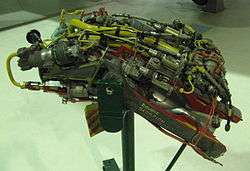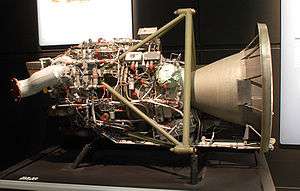Napier Scorpion
The Napier Scorpion family of rocket engines, (N.Sc.n / N.ScD.n / N.ScT.n), are a family of British liquid-fuelled rocket engines developed and manufactured by Napier at the Napier Flight Development Establishment, Luton, in the late 1950s.
 Double Scorpion, RAF Museum London | |
| Manufacturer | Napier |
|---|---|
| Application | aircraft booster |
| Predecessor | Napier Scorpion |
| Liquid-fuel engine | |
| Propellant | hydrogen peroxide / kerosene |
| Configuration | |
| Chamber | two |
| Performance | |
| Thrust | 8,000 lbf (35.6 kN) |
| Dimensions | |
| Length | 856mm (33.7in) |
| Diameter | 584mm (23in) |
| Dry weight | 98kg (216lb) |
Design and development
After World War II the Air Ministry issued specifications for a wide variety of rocket engines, both liquid and solid-fuelled. Napier responded with the design of a liquid-fuelled rocket which used catalysed Hydrogen Peroxide (H2O2), in the form of High Test Peroxide (HTP) as oxidiser and Kerosene as fuel.[1]
The Scorpion was a regeneratively-cooled HTP (High Test Peroxide)/ Kerosene bi-propellant rocket engine. Fuel and oxidiser were pumped by a single shaft turbo-pump driven by super-heated steam, generated by catalysing HTP. Engine starting was achieved by an electric pump supplying HTP to the turbo-pump decomposition chamber. Once started, a bleed off the turbo-pump oxidiser outlet fed the turbo-pump decomposition chamber to maintain flow of fuel and oxidiser. Due to the single-shaft turbo-pump operating both fuel and oxidiser pumps, flow of fuel and oxidiser were automatically maintained at the correct ratio. The Kerosene fuel is ignited thermally by the super-heated steam from HTP, decomposed by passing over a catalyst in a decomposition chamber, which is injected simultaneously into the combustion chamber.[2][3][1][1]
First run on 19 May 1956, the N.Sc.1 Scorpion was also fired in the air on the following day, mounted in the bomb-bay of an English Electric Canberra B.2.
Double Scorpion
The Double Scorpion (N.ScD.n) engine was simultaneously developed with the single-chamber Scorpion, consisting of two Scorpion engines mounted together with each unit individually controllable, developing double the thrust. From 1956 Double Scorpion engines were fitted experimentally to two Canberra light bombers, to improve high altitude performance.[4] On 28 August 1957 WK163, fitted with a Double Scorpion, broke the world altitude record, exceeding 70,000 ft (21,000 m).[5][6][7][8]
The Double Scorpion was also considered for use in the English Electric P.1A interceptor (which gave rise to the Lightning) and Aerojet General was chosen for projected United States production.
The Scorpion project was cancelled in February 1959, at a reported total cost of £1.25 million.[9]
Triple Scorpion
A triple-chamber version was also developed as the Napier Triple Scorpion (NScT.n), emerging as a Double Scorpion with a third chamber mounted centrally under the other two.[2]
Variants
- Scorpion NSc.1
- Initial development single-chamber engine
- Double Scorpion NScD.1
- Double-chamber engine
- Triple Scorpion NScT.1
- Triple-chamber engine
Notes and references
| Wikimedia Commons has media related to Napier Scorpion. |
- "Scorpion" (.pdf). Flight. 73 (2579): 900. 27 June 1958.
- Bridgman, Leonard, ed. (1959). Jane's all the World's Aircraft 1959–60. London: Sampson Low, Marston & Co. Ltd.
- "United Kingdom Aerospace and Weapons Projects: Rocket Engines". Skomer. Archived from the original on 5 February 2006.
- "Napier Rocket Engines" (PDF). The English Electric Journal. June 1957. Archived from the original (PDF) on 15 February 2006.
- "SCORPION-CANBERRA'S ,70,000ft:A New Aeroplane Height Record on Final Rocket Power" (PDF). Flight International: 379. 6 September 1957. Retrieved 21 December 2017.
- Popular Science. February 1958. Missing or empty
|title=(help) - "Napier Double Scorpion". Flight: 338. 30 August 1957.
- Compiled by Alan Vessey (1997). Napier Powered. Tempus. ISBN 0-7524-0766-X.
- "Cancelled projects: the list up-dated". Flight: 262. 17 August 1967.
